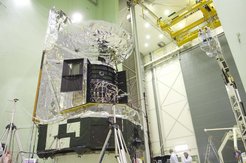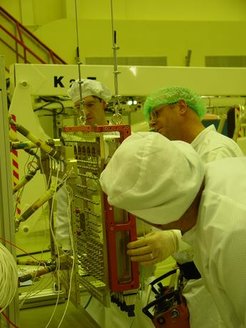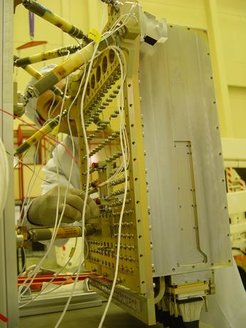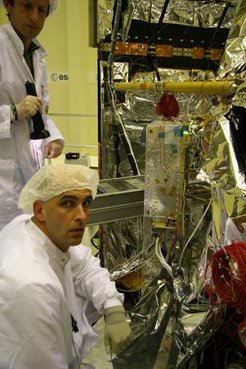HIFI Local Oscillator Integration at Satellite Level

In 2008 the LOU has been integrated mechanically and ellectrically on the satellite in the ESA/ESTEC cleanroom facilities in Noordwijk/NL. Since then, operation of the unit is only possible via the satellite control system.
The picture shows the Herschel Satellite after the Integration of the Local Oscillator Unit and its radiation shield. To get the unit optically aligned to the focal plane unit, an alignment camera system has been used. The optical reference of the LOU is an optical device of pentaprisms which distinguishes tilt angle from lateral offsets. The mechanical interface to the satellite is very critical considering alignment. It had to be ensured that mounting the Unit on the satellite does not influence the internal alignment of the 14 THz beams. The verification of these could only be performed at cryogenic temperatures. Therefore the mechanical integration process was done in a sequence of exercises, where the Unit was integrated to the interface while measuring the bending forces on its struts, after the alignment was achieved (see pictures below).


After the Unit was electrically connected to the satellite system, we had a last opportunity to check the connector mating, before the Satellite was moved into the Thermal/Vacuum chamber in November 2008. The below picture shows the LOU at its satellite interface. The operation of the unit in the Thermal/Vacuum chamber was a very critical test for this subsystem. The flight harness between the LOU and its control unit (LCU) was now tested in cold conditions for the first time, and, the unit itself has been cooled via its radiation shield also for the first time. The cooling turned out as it was predicted by analysis. Only the temperature profile in the unit had changed in comparison to the crygenic tests on unit level, where active cooling in a dedicated cryostat was performed. This had a strong impact on the operational parameters and it costed days to get the unit into an operational mode. This was a warning to us, what we have to expect, when we switch on the unit in space. 11 days after the ARIANE V launch, we will have the first contact to our subsystem. After switch on we will perform a functional test on it. The analysis of the housekeeping data will tell us how to adjust the 101 parameters needed to make the system work.




